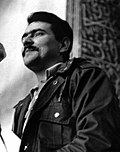Campaign
During the elections, Islamic Republican Party had the upper hand when many clerical organizations and friday prayer imams endorsed IRP candidates and the National Television gave them extra time. Their campaign literature featured large pictures of Ayatollah Khomeini, who urged the voters to elect candidates with "Islamic qualifications", on the grounds that only such candidates are able to draft a genuine Islamic constitution. [5]
Different leftist groups fielded candidates for the elections, including the Tudeh Party of Iran, the Organization of Iranian People's Fedai Guerrillas, the Organization of Struggle for the Emancipation of the Working Class and the Socialist Workers' Party of Iran. Among the nominees of the latter was the only soldier to run in the elections and two people in Khuzestan Province who campaigned while being jailed. [6]
People's Mujahedin of Iran ran 26 candidates under its banner, including Massoud Rajavi in Tehran, Mousa Khiabani, Ahmad Hanifnejad and two others in Azerbaijan, eleven in central provinces, six in the northern provinces of Caspian and four in Khorasan. [7]
Boycott
Several parties including National Front and National Democratic Front boycotted the elections in protest to the new press law, the result of which was to close many newspapers. [8] They also protested the election method, in which the voters should write names of the candidates on the ballot slips. They regarded it questionable, considering the high rate of illiteracy at the time. [9]
Pan-Iranist Party was also among the boycotting groups. [10]
Results
The Islamic Republican Party and its Khomeinist allies won the election, securing an absolute majority of seats. Of all members elected, 58 were candidates supported by the IRP-led Great Islamic Coalition while the Freedom Movement of Iran and the Muslim People's Republican Party had endorsed 7 and 6 respectively (some were included in more than one list). [4] The IRP was successful nationwide except for East Azerbaijan and West Azerbaijan, both MPRP strongholds, as well as Sistan and Baluchestan where Sunni candidates won. Secular candidates were defeated by a wide margin and most of the members elected were not only Islamist, but also were clerics, as stated by Ervand Abrahamian:
The winners included 15 ayatollahs, 40 hojjat al-Islams, and 11 IRP-sponsored intellectuals. The only successful candidates not affiliated with the IRP were: Taleqani, who obtained by far the most votes in Tehran – however, he died soon after the elections; another Tehran cleric close to both Taleqani and the Mojahedin; two provincial clerics sympathetic to Bazargan; three delegates from Azarbayjan sponsored by Shariatmadari's Islamic People’s Republican Party; one member of the Liberation Movement; one spokesman of the Kurdish Democratic Party, who was promptly barred from his seat; and the four representatives of the official religious minorities, the Armenians, Assyrians, Jews and Zoroastrians. [5]
Summary
A summarised results of the parties that won seats at the election is as follows:
This page is based on this
Wikipedia article Text is available under the
CC BY-SA 4.0 license; additional terms may apply.
Images, videos and audio are available under their respective licenses.








